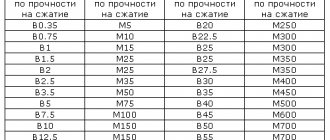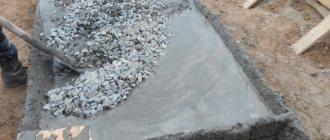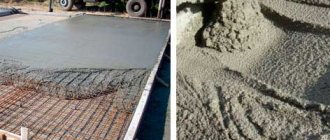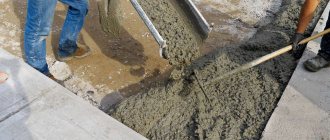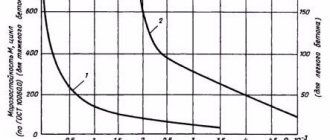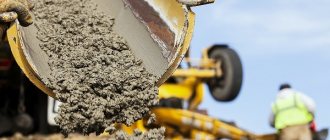Concrete is one of the most widely used materials in construction. Along with such properties as strength and durability, frost resistance is an important characteristic of concrete.
This quality is especially important in Russia, where many regions are characterized by harsh climatic conditions: changes in temperature and humidity, very low temperatures, due to which concrete can be saturated with water, salt solutions, and then subjected to repeated freezing and thawing.
Let's consider what frost resistance is, what methods are used to determine it, and whether it can be increased.
Why is frost resistance of concrete important?
Concrete, being a durable material, still has a porous structure; it always has pores and capillaries that can absorb moisture.
In autumn, as well as in winter, during thaws, concrete structures are saturated with water with minerals dissolved in it (upon contact with wet soil and precipitation, which may contain aggressive substances from man-made emissions). Then frosts occur, and all the moisture remaining in the pores of the concrete freezes, increasing in volume.
As a result, microcracks appear, and with each freeze-thaw cycle, these cracks become larger until the concrete begins to crumble.
What methods are used to test frost resistance?
The samples that are tested are concrete cubes with a side size of 10 or 15 cm. They are selected from each batch of concrete into standard forms in accordance with GOST 22685. Each series of samples is made from one batch of concrete.
GOST determines how concrete is selected and how samples are stored.
Important!
Determination of frost resistance begins only after the samples have reached their design strength.
The samples are kept for 24 hours in water or salt solution, immersed at 1/3 of the height. After 24 hours, the liquid level doubles, and the sample is again kept for 24 hours. For the next 48 hours, the cubes are left completely immersed in the solution or water.
Tests are ongoing continuously.
Test methods are divided into two groups:
- basic,
- accelerated.
First
The first method is used for any type of concrete, except for concrete for airfield and road surfaces, as well as concrete that will be used under conditions of exposure to mineral-rich water (these types of concrete are tested by the second basic method).
The first method involves freezing moisture-saturated samples in air and then thawing them in water (water temperature 20+/–2°C).
When using the second basic method, samples saturated with a solution of sodium chloride are frozen in air and thawed in a solution of NaCl (table salt).
After carrying out the planned number of tests, the change in the mass of the samples and their strength is measured and, using calculations using special formulas, the grade of concrete is determined by frost resistance.
Second
The second method is used for all types of concrete, except for those intended for airfields and road surfaces and lightweight concrete, which will be used under conditions of exposure to mineralized water.
Third
Used for all types of concrete, except lightweight concrete.
Accelerated methods use samples saturated with NaCl solution. They are frozen in air and thawed in a 5% salt solution.
The test results are then processed in the same way as when using basic methods.
The basic methods include the first and second, and the accelerated methods include the second and third.
Table of correspondence between brand and frost resistance and water resistance indicators
For convenience, users are recommended to use the table. 1.
Table 1: Characteristics of concrete mixtures
| Concrete grade, M | Concrete designation | Frost resistance class, F | Water resistance index, W |
| 100 | 7,5 | 50 | 2 |
| 150 | 12,5 | 50 | 2 |
| 200 | 15 | 100 | 4 |
| 250 | 20 | 100 | 4 |
| 300 | 22,5 | 100 | 6 |
| 350 | 25 | 200 | 8 |
| 400 | 30 | 200…300 | 10 |
| 450 | 35 | 200…300 | 8…14 |
| 500 | 40 | 200…300 | 10…16 |
| 550 | 45 | 200…300 | 12…18 |
| 600 | 47,5 | 300 | 14…20 |
Price table
Cost indicators for the Tula region for 2022 are shown in table. 2.
Table 2: Price of ready-mixed concrete without delivery
| Concrete grade | GOST designation | Inert filler | Price of concrete on site at the plant, excluding delivery, rub. |
| M100 | BSG B7.5P4 F50 W2 | crushed stone | 3 000 |
| M150 | BSG B12.5 P4 F50 W2 | crushed stone | 3 100 |
| M200 | BSG B15 P4 F75 W4 | crushed stone | 3 200 |
| M200 | BSG B15 P4 F75 W4 | crushed stone | 3 600 |
| M250 | BSG B20 P4 F75 W4 | crushed stone | 3 300 |
| M250 | BSG B20 P4 F75 W4 | granite (marble) chips | 3 700 |
| M300 | BSG B22.5P4 F100 W6 | granite (marble) chips | 3 400 |
| M300 | BSG B22.5P4 F100 W6 | granite (marble) chips | 3 800 |
| M350 | BSG B25P4 F150 W8 | granite (marble) chips | 3 650 |
| M350 | BSG B25P4 F150 W8 | granite (marble) chips | 3 900 |
| M400 | BSG B30 P4 F200 W10 | granite (marble) chips | 4 100 |
| M450 | BSG B35 P4 F200 W10 | granite (marble) chips | 4 300 |
| M550 | BSG B40 P4 F300 W12 | granite (marble) chips | 4 700 |
What types of frost-resistant concrete are there, and where are they used?
For effective construction, it is important to know exactly what the frost resistance of concrete is. That is why concrete is assigned a frost resistance grade. It is designated by the letter F and a numerical indicator in the range from 25 to 1000:
- Concrete with frost resistance up to F50 is used mainly for interior and preparatory work.
- F50–F150 shows average frost resistance values. Such concretes are suitable for the construction of facilities that will be operated in temperate climates.
- Concretes F150–F300 are intended for construction in cold regions.
- Grades above F300 are used for construction in extremely cold conditions, as well as for special-purpose facilities.
What determines the frost resistance of concrete?
Obviously, the weak resistance of concrete to low temperatures is associated with its ability to become saturated with water, which will subsequently freeze. And the saturation with water is higher, the more pores and capillaries in the concrete.
Pores and capillaries also influence the water permeability and strength of concrete.
There is a direct relationship: the denser the concrete, the smaller and smaller the diameter of the pores and capillaries in it, the more durable, waterproof and frost-resistant it is. This means that dense and durable concrete will be the most frost-resistant.
Increasing the frost resistance of concrete
Considering that in most territories of Russia the climate is harsh, the question of how to increase the frost resistance of concrete is a pressing one. This indicator is influenced by:
- number and size of pores in the structure;
- cement composition;
- tensile strength.
Knowing what frost resistance depends on, you can improve the quality using several methods:
- Reducing the amount of moisture in the mixture, using uncontaminated fillers or special additives.
- Reducing macroporosity. This requires creating conditions for rapid hardening of the solution and the use of additives that reduce the need for moisture.
- Applications of freezing the mixture at a later age.
- Insulation to prevent exposure to negative conditions (using paints and impregnations that increase the service life of concrete products).
- Application of chemical additives (solutions of hydrochloric, carbonic, nitric acids). They help increase the number of small pores into which water cannot enter.
Working with structure
To increase the frost resistance value, you can influence the structure. To achieve the effect, use several methods:
- The structure is frozen after complete hardening in the fourth week. This leads to a decrease in the number of pores as a result of the disappearance of air bubbles.
- Carefully compact the solution during installation. At the same time, the working mass is compacted, getting rid of air.
- Reduce the amount of water when mixing the solution. To obtain the desired effect, it is necessary to use aggregates that are free of dirt and dust.
If the technology for preparing and laying the mortar is followed, it must be compacted: there are no air bubbles and pores in heavy concrete. Using simple methods, it is possible to obtain the greatest resistance of the material to freezing and subsequent thawing.
Waterproofing
In order to increase the resistance of concrete to frost, waterproofing is not used. However, protecting the structure from water access increases the material’s resistance to temperature changes. The dry material can withstand severe frosts more easily and its performance properties suffer less.
Water is the main destroyer of concrete as a result of freezing: turning into ice, it destroys the structure from the inside. By removing the source of moisture, further deterioration of the structure can be prevented.
Waterproofing is performed in several ways:
- The simplest is considered to be roll. Bitumen-based sheets are laid on the surface (vertical or horizontal). All seams are treated with a torch or mastic.
- Penetrating - allows you to strengthen the surface of the structure and compact it to prevent water penetration.
- Coating is often used together with roll coating, because as an independent method of protection it is not durable.
Additives
The frost resistance class of concrete can be significantly increased through the use of plasticizing additives. Their purpose is different:
- Special ones that increase frost resistance. Their operating principle is based on changing the pore structure to the smallest
- Complex ones are used to improve several properties of the product at once: water resistance, density, resistance to temperature changes.
- To prevent water from entering the structure of the material and damaging the structure, water repellents are used.
To improve the class of concrete according to this indicator, the following additives are used:
- Accelerating the hardening process, promoting rapid compaction of the structure (sodium nitrate, calcium nitrate). Affect the time it takes for the solution to set. Allows you to speed up the construction of structures by reducing the hardening time.
- Retards hardening by allowing air bubbles to escape (urea).
- Universal (superplasticizer C3, consisting of a mixture of sodium salts and polymethylene naphthalene sulfonic acids). They affect the mobility of concrete, affecting water resistance and strength. Reduce cement consumption.
- Modifiers - can significantly increase strength indicators. At the same time, they increase resistance to corrosion and low temperatures.
- Complex additives that increase strength, density, frost resistance (lignosulfates). At the same time, they influence several operational characteristics: they can reduce water consumption, increase resistance to corrosion and frost, and slow down the hardening process.
Additives containing chloride reduce the resistance of reinforcement to corrosion, but additives based on sodium nitrite delay this process.
How to increase the frost resistance of concrete
To obtain dense and durable concrete, the following conditions must be met:
- Use high-quality, high-grade cement. If concrete work is planned at low temperatures, or if increased requirements for frost resistance, strength, and water resistance are placed on concrete, a higher grade of cement is used.
- To increase the water resistance of concrete, use aluminous cements.
- Choose the correct water-cement ratio.
- Ensure that the concrete mixture is placed and compacted correctly so that there are no voids in the finished concrete.
- Provide concrete care and optimal hardening conditions so that the concrete gains high quality strength (air temperature +18–22°C, air humidity close to 100%).
- Use various additives for concrete.
What additives are used for concrete
To obtain impeccable concrete, special chemical additives are developed to give the material certain desired properties. To increase the frost resistance of concrete, it is necessary to increase its density and water resistance. For this purpose, plasticizers and water repellents are used.
We advise you to study: Plasticizers for concrete
Plasticizers, such as Plastix from Cemmix, act as follows:
- They allow you to save up to 10–20% of cement without loss of strength or, without increasing the amount of cement, to obtain more durable concrete.
- They increase the mobility of the concrete mixture by 1–2 steps without increasing the amount of mixing water. The fact is that the amount of water required for hydration reactions to occur is much less than the amount of water required to mix a plastic and easy-to-lay concrete mixture. However, if you increase the water-cement ratio, there will be excess water in the mixture. It will not react with cement particles and will evaporate over time, but will leave extra pores in the concrete, which will negatively affect both its strength, water resistance and frost resistance. Adding a plasticizer completely solves this problem, because with it the concrete becomes more mobile and easier to work with without loss of strength.
- Concrete mixture with plasticizer, due to increased mobility, fits better. On the one hand, this allows you to save labor and energy costs for processing the laid concrete; on the other hand, the concrete is laid more densely, excess air is displaced, thereby reducing the number and diameter of pores and capillaries in the finished product.
- The concrete mixture with a plasticizer remains ready for work longer and does not delaminate, which increases the convenience of work.
In turn, additives intended for volumetric hydrophobization of concrete (hydrophobizers) increase the strength and frost resistance of concrete, protect reinforcement, and in some cases increase the mobility of concrete, making it possible to do without a plasticizer.
Important!
Plasticizers and water repellents are sometimes used together.
We advise you to study: Water repellents for concrete
What it is?
This is a kind of section of the floors, walls and ceilings of buildings, filled with insulating material (sealant, putty, elastic bands), which divides the facade of the building into separate sectors. Its main function is to prevent deformation, displacement or destruction of the building, take away some of the tension from the frame and increase the elasticity of the blocks.
There are many types of seams, differing in purpose of application, but the most popular of them are the following:
Some types of joints are used more often than others.
- temperature-shrinkable seams;
- sedimentary;
- antiseismic.





